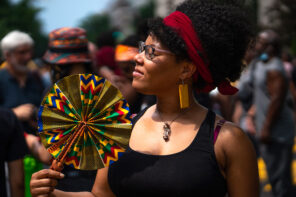If you want to find the Occupy Movement now, just go here: exile, diaspora, online, viral, on radio, at Thanksgiving tables, over coffee, in Los Angeles and Poughkeepsie and Riverside and more. Everybody wants to know where it is—and it is everywhere.
On Monday night, November 14, 2011, the mayor of New York City ordered the police to evict the 500 or so overnight occupiers in Zuccotti Park. As part of the eviction, tents and computers, books and papers, food and toilet paper were destroyed, actually ground fine in dumpsters. Many falsely thought the movement wouldn’t survive its physical eviction and material destruction. They were and are wrong.
Sacred space may start with tents and have a middle stage in church buildings, even sanctuaries. But sacred space has no need of one place. It can occupy many at the same time. They did not destroy all the books in the Occupy library. Some of those books are being retrieved at the New York Police Department “lost and found.” Sacred space is not one place; and you can grind a book to dust but not destroy it.
Judson Memorial Church opened our church’s assembly room for five nights the first week and still have an astonishing collection of notebooks, backpacks, sleeping bags and down comforters, sweaters, sweatshirts, and mittens hanging out in our hallways. We think people may pick this stuff up but we aren’t completely sure. The stuff is heartwrenching—but not nearly as heartwrenching as the demands about who has stuff and who doesn’t, who lives in a tent and who doesn’t, who has financial security and who doesn’t. This matter is larger than any stray mitten or powerful moment.
People love to stay immune from the connections between the sacred and the profane, holy space and “regular” space, tented space and the well-appointed space of a mansion. They try to tell us that politics and religion never meet. Or that money is “dirty” and therefore can get away with its meanness. Deliverance from these false dichotomies is our greatest need as a country. Money is holy and just and good when used for holy and just and good purposes. It is not “dirty” and therefore the property of those naughty boys of Wall Street.
Sacred Space is also never just one place or in one time. Zucotti was a beginning space, not an ending space. Deliverance from the dichotomy of sacred space and scattered space is also important to the movement as it matures in diaspora. Consider first the way in which too many Christians, Jews, and Muslims have imagined the city of Jerusalem as their privately or parochially owned sacred space. Or consider the fight about Ground Zero, a place considered so sacred by some that they found the possibility of a mosque near the site as desacralizing. The blend, not the division, of sacred and profane spaces really matters to justice and its hopes.
If the spirit of Occupy Wall Street and its home at “Liberty Square” is to survive and have impact, we occupiers need a larger understanding of what sacred space is and what it isn’t. Sacred space can be anywhere, any time.
Lots of people want to turn this yearning for holy uses of money into a fight between cops and people or pepper spray and meeting rooms. When sacred space is distorted into private property, sacred space rigidifies in ways that make the fights between people small. Here it could make the police into our enemy when actually they are part of the 99%. Occupy need not be anywhere to achieve its objectives. In fact, the more everywhere it is, the better. You can occupy everywhere, as long as your original purpose is something larger than one place. You can also get stuck anywhere, if your purpose is to stay in one place as though it was yours.
When sacred space is opened and understood to be anywhere, any time, you can occupy a tent or a street corner and still tell a story about economic justice.




